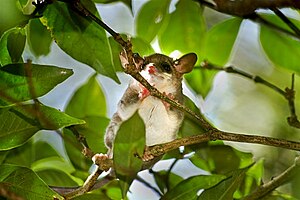Gray slim-pouch rat
| Gray slim-pouch rat | ||||||||||||
|---|---|---|---|---|---|---|---|---|---|---|---|---|

Gray slender-pouch rat ( Marmosops incanus ) |
||||||||||||
| Systematics | ||||||||||||
|
||||||||||||
| Scientific name | ||||||||||||
| Marmosops incanus | ||||||||||||
| ( Lund , 1841) |
The gray slender- pouch rat ( Marmosops incanus ) is a species of marsupial that occurs in eastern and southeastern Brazil from Sergipe in the north to São Paulo in the south. Whether it is a monotypical species or several cryptic species is not yet certain.
description
The animals reach a body length of 12.7 to 19.4 cm (males) or 10 to 15.8 cm (females), have a 14 to 23 cm long tail and weigh 25 to 140 g (males) or from 20 to 72 g (females). The fur is brown-gray on the back and the top of the head. There are noticeable dark circles around the eyes, the area between the eyes is light gray and the cheeks are cream-colored to whitish. Depending on the region, the dark circles under the eyes are more or less pronounced. A central dark line on the muzzle is missing. The peritoneum is cream-colored and shimmers slightly pink in some individuals. The tops of the feet are white. The ears are relatively large with a length of 25 mm. The tail, the length of which is about 130% of the length of the head, is dark on the upper side and light on the underside. The tip of the tail is white. Females do not have a pouch. The length of the hair changes with age. In young animals the fur on the back is about 10 mm long and very soft, in older animals the back hair is 5 mm long and coarser. The peritoneum, on the other hand, always remains soft and long like the back fur of young animals. Overall, the specimens from drier areas are usually lighter than those from humid forests.
Habitat and way of life
The gray slim-pouch rat lives in the Atlantic rainforest up to heights of 800 meters. It also occurs in gallery forests in the Caatinga and Cerrado , which are connected to the Atlantic Rainforest, and at higher altitudes in island-like moist and semi-dry forests in the Caatinga.
The slender-pouched rat is probably nocturnal. Compared to larger opossum species, it moves very quickly and is able to jump over small obstacles. In the heavily deforested and fragmented Atlantic rainforest, she prefers the island-like forest remnants and largely avoids the cultivated land in between but also the forest corridors between the forest islands. The territory used by an individual is between 0.4 and 2.1 hectares in size. The territories of the males are about 50% larger than those of the females. Whether they live more on the ground or more in the undergrowth is still controversial.
Females build nests in the undergrowth that are on average less than 2.5 m above the ground. Artificial nesting aids are also used. The animals become sexually mature at the age of 6 months and in most cases only reach an age of one year. They only reproduce once in a lifetime in the months from October to March.
nutrition
The gray slim-pouch rat feeds mainly on invertebrates, especially insects. Their prey includes beetles , grasshoppers , ants, spiders and caterpillars. Fruits are also consumed. In the cerrado, more remains of ants were found in fecal samples compared to fecal samples from wet forests. In addition, many termites and cockroaches are consumed in the cerrado . In gallery forests, the slender-pouched rat has an important role in the distribution of seeds of various plant species.
status
Since the gray slim-pouch rat has a large distribution area, is relatively common and occurs in several protected areas, it is considered safe.
supporting documents
- ↑ a b c d e f g Diego Astúa: Family Didelphidae (Opossums). in Don E. Wilson , Russell A. Mittermeier : Handbook of the Mammals of the World - Volume 5. Monotremes and Marsupials. Lynx Editions, 2015, ISBN 978-84-96553-99-6 . Page 182 and 183.
- ↑ Marmosops incanus in the endangered Red List species the IUCN 2015 Posted by: Brito, D., Astua de Moraes, D., Lev, D. Soriano, P. & Emmons, L., 2015. Accessed January 21 2019.
